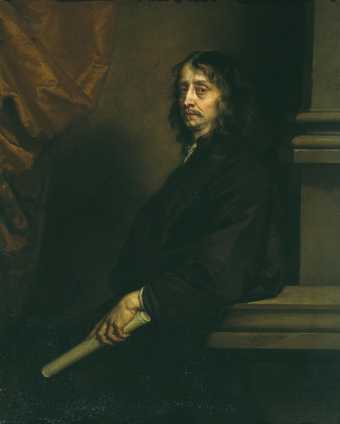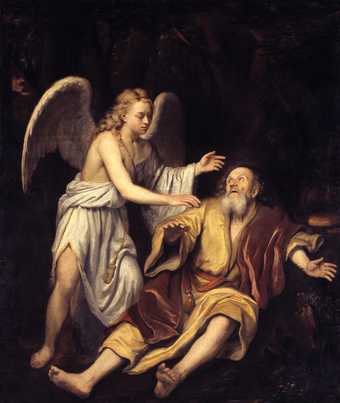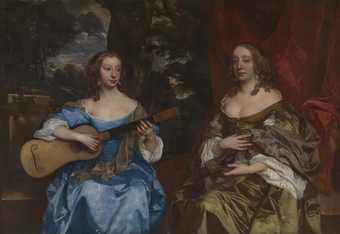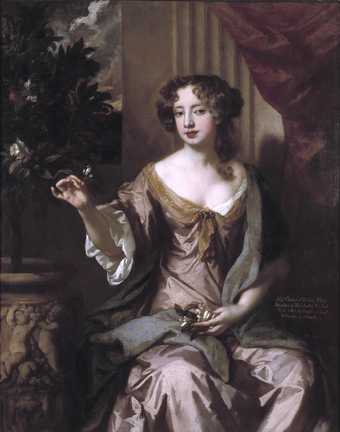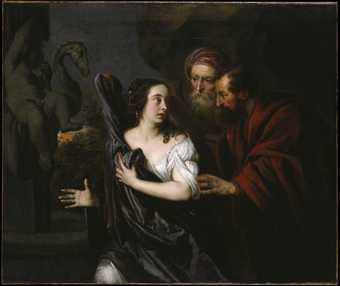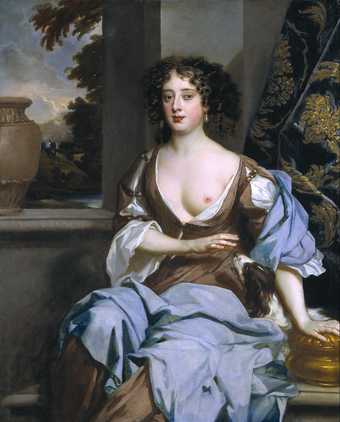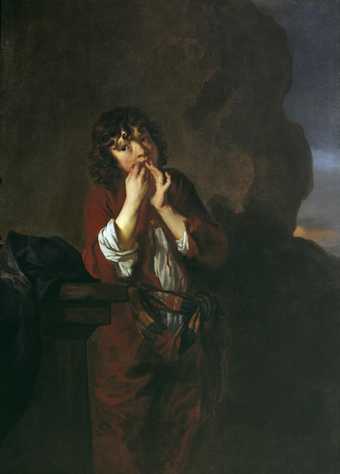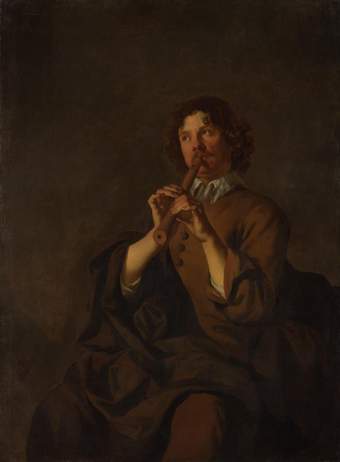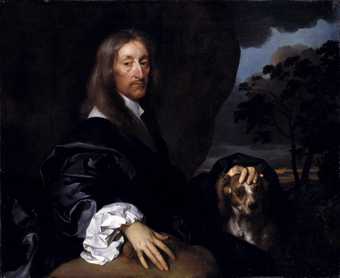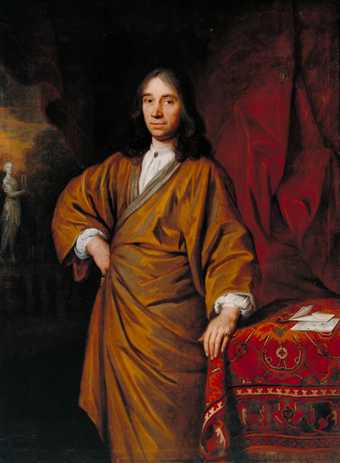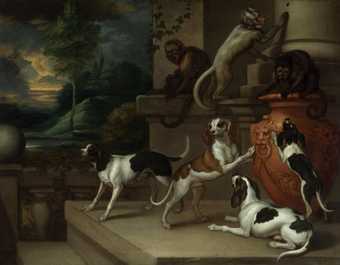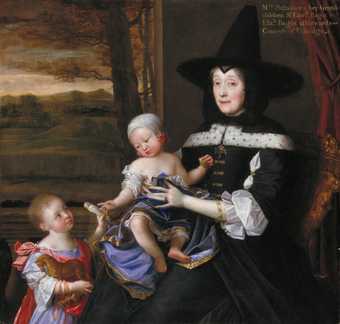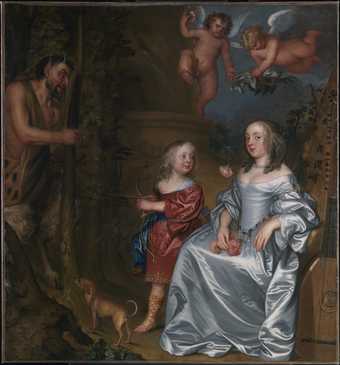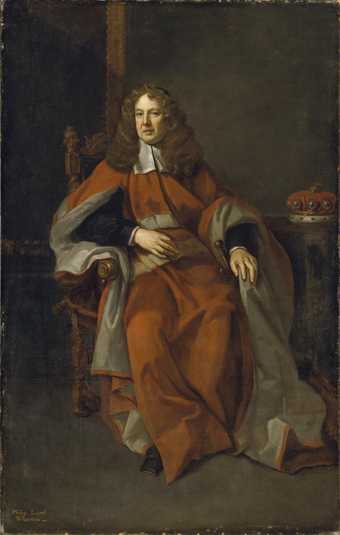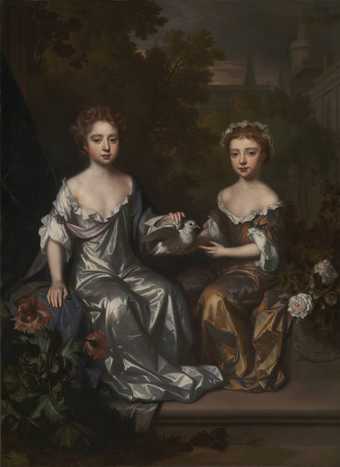
Not on display
- Artist
- Sir Peter Lely 1618–1680
- Medium
- Oil paint on canvas
- Dimensions
- Support: 1245 × 1016 mm
frame: 1547 × 1315 × 125 mm - Collection
- Tate
- Acquisition
- Bequeathed by Wynn Ellis 1876
- Reference
- N01016
Display caption
Gallery label, February 2004
Does this text contain inaccurate information or language that you feel we should improve or change? We would like to hear from you.
Catalogue entry
Sir Peter Lely 1618–1680
Girl with Parrot
c.1670
Oil on canvas
1245 x 1016 mm
Bequeathed by Wynn Ellis 1876
N01016
Ownership history
... Wynn Ellis, by whom bequeathed to the National Gallery in 1876; transferred to the Tate Gallery 1919.
References
R.B. Beckett, Lely, London 1951, p.46, no.212.
Lely depicts this little girl, whose identity is unknown, as if she were a grown woman. In a fold of her blue satin dress she carries cherries, which she proffers to an African grey parrot perched on a stone parapet in front of rose bushes, to the left. Her loose frock is of a type that Lely often used in his portraits of adult ladies. Comparatively unaffected by passing fashion, it gave a portrait a timeless quality, while revealing the subject’s physical charms. Cherries were a widely recognised symbol of innocence and are commonly found in early portraits of children, particularly by Netherlandish artists.
The parrot would be an exotic pet of a wealthy family. For instance, the memorial waxwork effigy in Westminster Abbey in London, of Frances Stuart, Duchess of Richmond (1647–1702) – the court beauty whom Charles II (reigned 1660–1685) pursued unsuccessfully from 1663 to 1667 – is accompanied by the stuffed body of her African grey parrot, which had lived with her for forty years.1 An expensively imported parrot was primarily a high-status object, but parrots had also appeared in earlier religious paintings to symbolise the purity of Mary, the mother of Christ.2 This symbolism may still be partly active in the present work, the purpose of which was probably to present the sitter as suitable for marriage.
A parallel example of a work that served this function is Lely’s portrait of Lady Charlotte Fitzroy with a Black Attendant c.1672 (York City Art Gallery). Lady Charlotte was portrayed at the age of about 8 in around 1672, shortly before she was betrothed to Sir Edward Lee.3 Like the present sitter, she has bare feet and her loose satin gown reveals her naked childish shoulders.
Sir Peter Lely was born to a Dutch family in Soest, Westphalia, in 1618. He trained in Haarlem and at the beginning of the 1640s moved to England, where the Civil War had begun.4 In London, Lely had the opportunity to see many examples of the work of the recently deceased Sir Anthony van Dyck (1599–1641) whose portraits had transformed the public image of Charles I’s court. The market for art in Britain at this period was almost entirely for portraiture, and Lely increasingly concentrated on that field, absorbing the influence of van Dyck and steadily lightening and brightening his own palette.
Upon the Restoration of the Stuart monarchy in 1660, Lely became a principal portrait-painter at the court of Charles II. Highly prolific, he employed other painters to carry out the less individualised areas of his pictures, such as the drapery. He often re-used the same pose for different sitters. A painting of an entirely different little girl dressed, as here, in blue, beside an orange curtain, proffering cherries to a parrot and in a very similar posture, but revealing more leg, was among a group of portraits said to be by Lely and mostly of members of the Percy family sold from the Castle Howard collection during the Second World War.5 Photographs suggest that much of it was less sophisticated in handling than the Tate work.
The present painting was bequeathed to the National Gallery by Mr Wynn Ellis in 1876. There are no records as to when or where he had acquired it. It was transferred to the Tate Gallery in 1919.
Karen Hearn
April 2008
Notes
Features
Explore
- architecture(30,960)
- emotions and human qualities(5,345)
-
- innocence(39)
- clothing and personal items(5,879)
- fruit, cherry(10)
- curtain(250)
- actions: postures and motions(9,111)
-
- standing(3,106)
- girl(1,079)
- individuals: female(1,698)
- soul - bird(3)
You might like
-
Sir Peter Lely Frans Mercurius van Helmont
1670–1 -
Sir Godfrey Kneller Elijah and the Angel
1672 -
Sir Peter Lely Two Ladies of the Lake Family
c.1660 -
Sir Peter Lely Elizabeth, Countess of Kildare
c.1679 -
Sir Peter Lely Susanna and the Elders
c.1650–5 -
Sir Peter Lely Portrait of an Unknown Woman
c.1670–5 -
Sir Peter Lely Boy Playing a Jew’s Harp
c.1648 -
Sir Peter Lely Man Playing a Pipe
c.1648 -
Gilbert Soest Portrait of a Gentleman with a Dog, Probably Sir Thomas Tipping
c.1660 -
Sir Godfrey Kneller Portrait of John Banckes
1676 -
Francis Barlow Monkeys and Dogs Playing
1661 -
John Michael Wright Portrait of Mrs Salesbury with her Grandchildren Edward and Elizabeth Bagot
1675–6 -
John Hayls Portrait of a Lady and a Boy, with Pan
1655–9 -
Sir Godfrey Kneller Philip, 4th Lord Wharton
1685 -
Willem Wissing Portrait of Henrietta and Mary Hyde
c.1683–5

